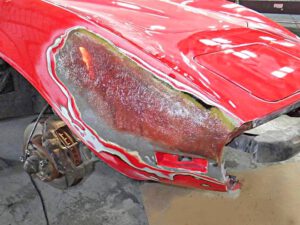Fiberglass Repair: How to Repair Holes in Boat Hulls, Surfboards, and Other Structures
Fiberglass can be used to repair holes in boat hulls, surfboards, and other structures that are amenable to fiberglass repair. This can help reduce the cost of repairing these structures and maintain their structural integrity.
A fiberglass repair kit contains West System epoxy resin and hardener, fiberglass cloth, application tools, and illustrated instructions for making several types of fiberglass repairs.
Fiberglass is a popular material that’s used for bathtubs, roofs, airplanes, and boats. It is very strong and durable, but like any material, it can be damaged. The good news is that fiberglass is very easy to repair if you follow the proper steps. The first step is to assess the damage. If the damage is minor, such as a scratch or small hole, you can do the repair yourself. If it is more serious, you should contact a professional to determine the extent of the damage.
The next step is to clean the area and prepare it for the new fiberglass. This is important because the surface must be clean for the epoxy to adhere properly. A good way to do this is by wiping the area with a cloth dampened with acetone. This will remove any contamination and loosen the gelcoat. You will also want to sand the area and make sure it is smooth, and then vacuum it.
Once the area has been cleaned and sanded, it’s time to mix the fiberglass resin and hardener. Follow the instructions on the packaging for this. It’s important to use a resin that is rated for fiberglass because it will provide the best strength and durability.
After mixing the resin and hardener, you can begin to lay down the fiberglass layer. For this, you’ll need a peel ply, which is a type of non-stick surface that will allow the epoxy to cure without leaving a blue color behind on the fiberglass. This will make the final product look better and be easier to work with.
For the fiberglass layer, it’s important to lay it out ply by ply, so you can build up a thick and strong structure. You can either do this directly on the repair area, or you can build it on a separate work surface and wet out each ply before applying it to the boat.
You should also lay down a colored gel coat to protect the repaired surface. This will make the finish look good and help hide any flaws in the fiberglass. You can find these products in many different colors and easily match them to the color of your repair area.
Filling the hole
Fiberglass is a strong material that’s often used in bathtubs, showers, sinks, pools, and boats. Unfortunately, it’s not immune to damage. A hairline crack, for example, may require a fiberglass patch and gelcoat to restore it to its original strength. Fortunately, most of these repairs are fairly easy to do yourself. The first step is to examine the crack. If it is wide, use a sanding wheel or electric grinder to smooth the area. This will prevent the crack from extending further.
After smoothing the area, clean the repaired surface with a cloth dampened with acetone. This is necessary to remove any contamination and ensure proper bonding. The surface should also be sanded with 36–80 grit paper, depending on the severity of the damage. It is essential that the sanding be done in such a manner that you are down to the fiberglass laminate.
The next step is to mix and brush a thin layer of thickened epoxy onto the repair area. For this, you will need a good-quality epoxy resin such as TotalBoat 5:1 Epoxy Resin and the matching hardener in a ratio of five parts epoxy to one part slow hardener. Add a small amount of TotalBoat Silica Thickener to the mixture until it has “ketchup consistency.”
With this mixture, you will then brush it over the repaired area. The epoxy will fill any cracks or voids, creating a bond for the fiberglass patch. The repair surface should be kept free of debris and other materials that could interfere with the adhesion of the fiberglass. It is also a good idea to place painters’ tape around the damaged area. This will help prevent epoxy from leaking into areas that don’t need it and will also help protect the surrounding areas of your boat.
Low-risk machined holes such as the screw hole in the pictured seacock can be repaired by force-filling with thickened epoxy, bonding solid plugs in place, and using laminates of fiberglass. Higher-risk hole repairs such as the aforementioned seacock and through-hull fittings, however, will require more advanced techniques such as grinding both sides, bonding reinforcing fibers, sanding the entire repair flush, applying a high-quality gelcoat, and then buffing to a sheen.
cutting the fiberglass cloth
Fiberglass is a durable and strong composite material used to make everything from boat hulls to bathtubs. It is used in conjunction with epoxy resin to create a part that can be molded to the shape of an object or structure. Like other building materials, fiberglass is subject to damage and needs to be repaired. Fortunately, the process of repairing fiberglass is relatively simple and can be done by a novice with the right tools and instructions.
Before starting the repair, ensure that all surfaces to be worked on are clean and dry. This will help the resin bond to the surface and provide strength to the finished product. Wipe the area using a rag dampened with acetone to remove contamination and dust from the damaged surface. After sanding the area with low-grit sandpaper, wipe it down again using a rag dampened with a solvent such as acetone to further remove any contaminants and prepare the surface for the application of gelcoat and fiberglass.
When the surface is clean and dry, mark the line where you will cut the fiberglass cloth. This will help keep the lines straight when you cut it with a saw or jigsaw. Then, stretch the fiberglass fabric over a hard-working table. Depending on the size of the panel, you may want to use a tee square or drafting ruler to align it with the edge of the table and prevent crooked cuts.
Mix the appropriate amount of TotalBoat 5:1 Epoxy Resin and TotalBoat Slow Hardener in a clean plastic mixing cup, using the correct ratio to completely saturate the fiberglass mat or cloth you have chosen for your patch. Pour a small amount of the mixed, unthickened epoxy into another clean plastic beaker or cup to allow you to dip your fiberglass brush into it and wet out the first piece of fiberglass.
Once you have wetted out a piece of the fiberglass, carefully align it with the damaged area and place it down. Continue wetting out and placing down pieces of fiberglass until you have completely filled in the damaged area with a layer of fiberglass. Then, use the squeegee to remove any excess epoxy before it starts to gel. This step is important, as any excess epoxy will leave a dry and brittle area that cannot be smoothed with later coats of fiberglass resin.
Applying the resin
After the hole is prepped, the fiberglass resin jelly must be applied to the area. This is used as an adhesive to hold the fiberglass cloth in place and as a filler to close up the pores of the cloth so that a watertight surface will result. Apply the resin jelly liberally to the hole and surrounding area with a brush, covering it completely and allowing it to dry or cure before proceeding.
When working with fiberglass, it is important to work in a well-ventilated area and to wear the proper protective equipment, such as goggles, gloves, and a face mask. This is because the epoxy resin and hardener, solvents, and fiberglass reinforcement fabric can generate hazardous fumes. It is also important to take your time when applying the resin, as rushing can lead to mistakes and mishaps.
In the video below, our expert demonstrates how to properly mix the epoxy resin and hardener and how to wet out the fiberglass cloth. He also explains the importance of staggered layers when patching a fiberglass boat. You will want to start with the smallest patch first, then move up in size for the rest of the repair. This will ensure that the smaller patches bond with each other and that the largest patch bonds with the layer underneath it.
It is important to note that the resin we use for fiberglass is different from automotive or marine epoxy. Fiberglass resins have special additives that allow them to withstand chemicals and heat, as well as provide a strong bond to fiberglass. In addition, this type of resin has a surface tack that helps it adhere to surfaces while it is still wet.
To begin the fiberglass repair, you will need to brush a coat of resin-hardener mixture onto the damaged area, extending 2-3 inches beyond the repair. Then lay your pre-cut piece of fiberglass cloth or mat over the resin application. After the first piece of fiberglass is in place, brush additional resin over the fiberglass material with a dabbing motion. Then continue placing pieces of fiberglass and wetting them with the mixed, unthickened epoxy until the damaged area is patched.




